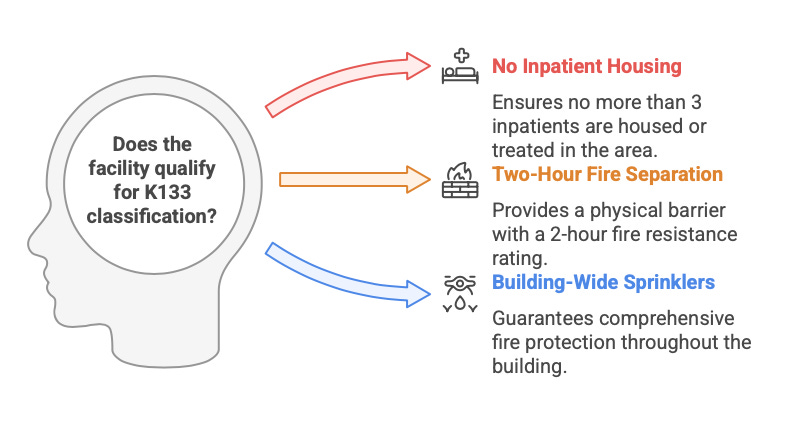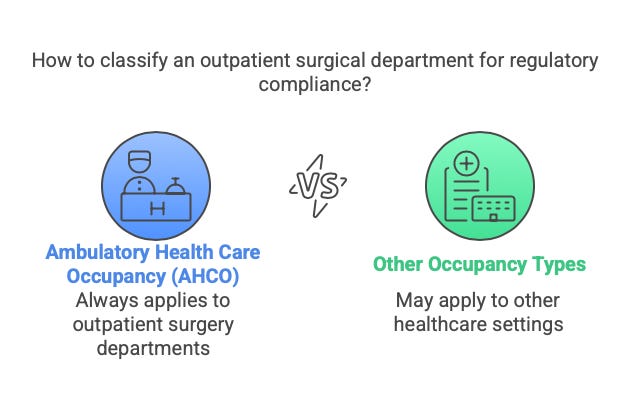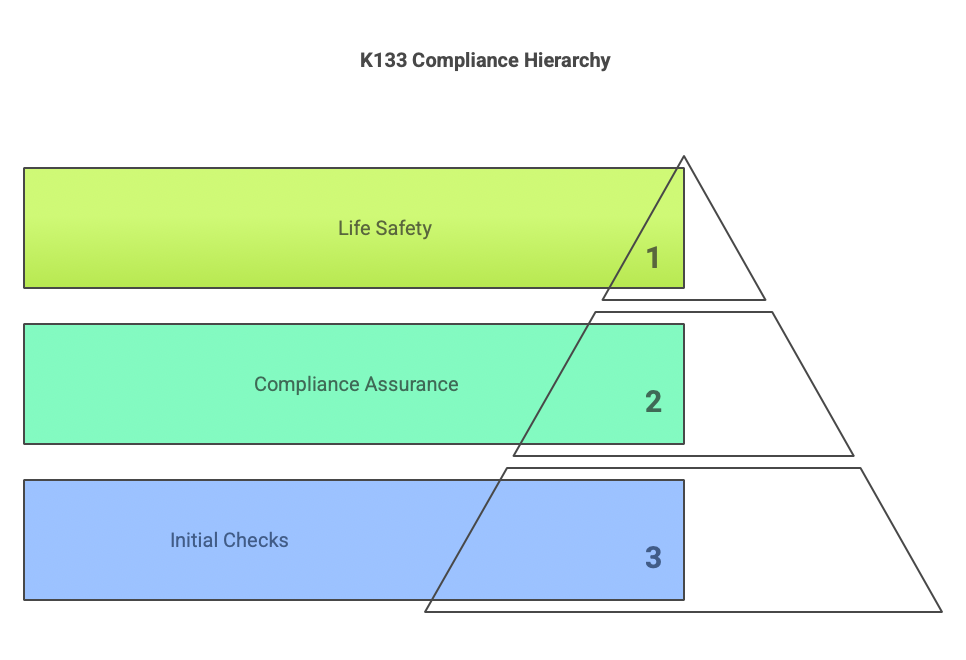K133: Multiple Occupancies
Understanding the Rules for Mixed-Use Spaces in Healthcare Facilities
K133: Multiple Occupancies – What You Need to Know (And Why It Matters)
Ever walk into a hospital and find yourself in what looks like a dentist’s office or outpatient clinic? If you’re wondering how that fits into life safety requirements—especially when it comes to K133—you’re not alone.
Let’s break it down.
What Is K133?
K133 addresses healthcare facilities that contain sections classified as other occupancies—meaning not every part of the building is considered a "health care occupancy" under NFPA 101.
Think:
Doctor’s offices
Outpatient imaging centers
Specialty clinics
Administrative areas
These spaces often feel like they're part of the hospital, but they may fall under a different occupancy type—usually business occupancy—depending on what services they provide and how they provide them.
So, What’s the Catch?
NFPA 101 doesn’t just let you carve out space for “other occupancies” without rules. To qualify, you must meet three specific requirements:
No Housing or Customary Access for Inpatients
These areas cannot serve 4 or more inpatients for housing, treatment, or regular access. If you’re treating or housing multiple inpatients, that changes the game.Two-Hour Fire-Rated Separation
These sections must be physically separated from the health care occupancy by a wall with at least a 2-hour fire resistance rating (per Chapter 8). That’s serious protection—like having a firewall between your garage and your house.Building-Wide Sprinkler Protection
The entire building must be protected by an approved, supervised automatic sprinkler system per NFPA 101 Section 9.7. This applies even to those small, seemingly unrelated spaces tucked into a corner.
Special Note: Outpatient Surgery Departments
If you have an outpatient surgical department, there's no wiggle room—it's always classified as an Ambulatory Health Care Occupancy (AHCO), regardless of how many patients you see. So even if you’re doing just three procedures a day, you’re still in AHCO territory. That brings with it a different set of standards altogether.
Annex A – The Friendly Guide (But Not the Rulebook)
The Annex is like the helpful friend who whispers in your ear during a survey: “This part can’t be enforced, but it’s useful.”
Here’s what it suggests:
If you have doctors’ offices or diagnostic/treatment spaces that are only for outpatients, are physically separated, and don’t house inpatients—they might be classified as business occupancies instead of healthcare.
As long as no more than three inpatients who cannot self-preserve are routinely treated in that space, you’re probably safe from needing full health care occupancy classification.
But once you hit four or more inpatients, it’s a health care occupancy—no exceptions.
What’s the Regulatory Tie-In?
K133 also points to the Code of Federal Regulations (CFR):
These federal regulations require compliance with fire safety and building codes, so everything mentioned here is not just an NFPA issue—it’s a survey issue too.
Bottom Line – Why It Matters
Understanding K133 helps you:
Avoid misclassifying occupancy types
Plan renovations or additions correctly
Prevent survey deficiencies
Ensure life safety compliance without overbuilding
If your facility has mixed-use spaces, don’t assume it’s just business as usual. Always check for:
Sprinklers?
Two-hour separation?
No inpatient housing or treatment in that section?
If all three are a “yes,” you’re likely in the clear for K133. If not, it’s time for a deeper review.
How I Can Help
Staying ahead of life safety compliance doesn’t have to be overwhelming. At Dustin Phillips Consulting, I make it easy for you and your staff to understand what’s required, prepare for surveys, and improve safety in your facility.
Whether it’s mock surveys, staff training, or a second set of eyes on documentation and fire safety plans, I bring real-world experience and a practical approach to compliance. My goal isn’t just to find issues—it’s to help you fix them before they become citations.
If you’re looking for clear guidance, hands-on training, and a partner who makes life safety surveys easier, let’s connect. A conversation today could save you a headache tomorrow.
Share & Stay Connected
Know someone who could benefit from this newsletter? Share it with your colleagues and friends—because life safety compliance is easier when everyone is informed.
Have someone who can benefit from Life Safety Newsletters like this, forward this to your colleagues and subscribe to my newsletter right here on The Code Chase. Newsletters can be sent directly to your colleagues, leadership, or friends email inbox!
For more insights, updates, and compliance tips, visit my website and connect with me:
🌐 Website: www.dustinphillipsconsulting.com – Learn more about my services, including mock surveys, training, and compliance support.
📩 The Code Chase Newsletter (Substack): Stay ahead of life safety compliance with The Code Chase, a newsletter delivered straight to your inbox. Get valuable insights, compliance tips, and industry updates—right where you need them. Share it with your colleagues, leadership, and friends to help them stay informed!
🔗 Linktree: Dustin Phillips Consulting – Access all my resources in one place, including important industry websites like CMS, CDC, NFPA, and more. You can also find this link on my LinkedIn and Instagram profiles.
💼 LinkedIn: Dustin Phillips Consulting – Follow for regular posts, compliance tips, and industry insights.
📸 Instagram: @DustinPhillipsConsulting – See posts on common deficiencies, compliance tips, and insights to help you stay prepared.
Let’s keep the conversation going—I’d love to hear your thoughts and answer any questions you have!
Let’s talk—reach out today!




